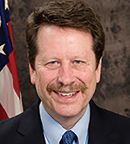
Ellen V. Sigal, PhD
Ellen V. Sigal, PhD, Chair and Founder of Friends of Cancer Research (Friends) began the annual meeting with a conversation with Douglas R. Lowy, MD, National Cancer Institute (NCI) Acting Director, and Robert M. Califf, MD, U.S. Food and Drug Administration (FDA) Commissioner.
“Cancer research is where it is today because of long-term funding by the public sector,” stated Dr. Lowy. He reminded the audience of the National Cancer Institute’s future work and the need for continued funding. “We are placing special emphasis on continuing development of the tumor cell atlas, and to implement new therapies and cancer prevention, specifically smoking cessation, colorectal cancer screening, human papillomavirus [HPV] (vaccine), and pediatric cancer treatment.”

One of the reasons it’s so successful is that we have brought the trial to patients rather than making patients come to us. There are now more than 1,000 centers participating.— Douglas R. Lowy, MD
Tweet this quote
Dr. Lowy also noted that the NCI-MATCH (Molecular Analysis for Therapy Choice) Trial was accruing about 500 patients a month—10 times more than had been anticipated. NCI-MATCH analyzes tumors to determine genetic abnormalities for which a targeted drug exists and then assigns treatment based on the abnormality. The study opened in August 2015 with 10 treatment arms and now has 24 treatment arms.
“One of the reasons it’s so successful is that we have brought the trial to patients rather than making patients come to us,” added Dr. Lowy. “There are now more than 1,000 centers participating.”
Dr. Califf talked about the new FDA Oncology Center of Excellence, headed by Acting Director Richard Pazdur, MD, FACP. He said it will “unify the clinical perspective of cancer as a disease, even though all the bureaucratic problems at the FDA remain. Data-sharing will be the next great revolution at the FDA. What you do with data, not just having the data, is the critical part.”

Data-sharing will be the next great revolution at the FDA. What you do with data, not just having the data, is the critical part.— Robert M. Califf, MD
Tweet this quote
Modernization of Eligibility Criteria
“Eligibility criteria are a critical component of clinical trials,” said Edward S. Kim, MD, Chair of the Department of Solid Tumor Oncology and Investigational Therapeutics, Levine Cancer Institute, Charlotte. “They can be inclusionary (specifying a tumor type or molecular alteration) or exclusionary in various ways.”
However, Dr. Kim continued, “Exclusionary trials improve the detection of a treatment effect and reduce risk, but overly restrictive criteria can impair accrual and decrease the applicability of trial results to ‘real-world’ patients.” Paul J. Hesketh, MD, Chair, Lahey Health Cancer Institute, Burlington, Massachusetts, noted that eligibility criteria have been relaxing over the past 20 years, especially regarding patients with comorbidities.
Dr. Kim and his panel looked at ways to expand eligibility criteria in four groups of patients who are traditionally kept out of trials.
- Brain Metastasis: Patients with brain metastasis do not have higher rates of serious adverse events, so if the metastasis has been treated and/or is stable, there is no reason not to include them in prospective trials. If there are specific safety concerns, they should be evaluated on a case-by-case basis without blanket exclusion.
- Minimum Age: People younger than age 18 usually can’t participate in trials until adult data are available, mainly because a high-profile adverse event could endanger the drug development program. Barriers that exclude children from adult trials include the lack of overlap between some pediatric and adult cancers, the potential for toxicity, and differences in metabolism. However, there is no reason why pediatric cohorts should not be part of an initial dose-finding trial, with older children enrolled first followed by younger ones. In later-phase trials that span pediatric and adult cancers, children should be included.
- HIV/AIDS: People infected with HIV now have a nearly normal life expectancy. For the most part, they have a low risk of AIDS-related problems and should be included in trials unless there is a specific reason not to do so.
- Organ Dysfunction: Except for abnormal creatinine clearance in the presence of nephrotoxic drugs, there is no reason to exclude patients with organ dysfunction.
The most significant benefit of expanded eligibility is more complete safety data, and the greatest risk of expanded eligibility is that patients who are sicker may have a greater likelihood of adverse events.

Nancy Roach
Nancy Roach, Founder of Fight Colorectal Cancer, said that if patients—with other cancers or brain metastasis, for example—are kept out of trials, when the drug is approved, there are no safety data that pertain to them, thus raising questions about how to treat them.
Richard Schilsky, MD, ASCO Chief Medical Officer, asked how a poor performance status might lead to increased risk and whether the Karnofsky and Eastern Cooperative Oncology Group (ECOG) scales should be modified.

Richard Schilsky, MD
Responses from the panelists were varied, but Dr. Hesketh summed it up best when he said that the magnitude of benefit from a clinical trial would increase and the frequency of adverse events would decrease by expanding eligibility criteria, especially with new targeted agents.
Real-World Data and Evidence
Gideon M. Blumenthal, MD, Clinical Team Leader, FDA Office of Hematology and Oncology Products, defined real-world data as findings collected outside of clinical trials, such as electronic health records and patients’ medical and clinical histories. Real-world evidence refers to data collected from the daily practice of medicine and reflects the heterogeneity of all patients—not just those in clinical trials. The two terms are often confused or used interchangeably, but both are useful when discussing a large effect size such as with a Breakthrough Therapy drug, where there is high confidence in efficacy data.

Gideon M. Blumenthal, MD
Concerns about data quality are legitimate when they are collected from private practitioners’ records. However, information from electronic health records is generally more complete and can be collected on more patients rapidly. The question, raised by Dr. Blumenthal, is: When can a clinical benefit be claimed in new indications in the “real world” (that is, not in a clinical trial) so that the evidence can be used to support label claims?
Dr. Califf talked a little about real-world evidence. He said it is not necessarily the “polar opposite of randomization, but it carries lots of discrepancies and inaccuracy.” Nevertheless, he acknowledged, “We can’t afford to continue doing clinical trials the way they’ve always been done.”
There are advantages to collecting real-world data and applying them to understanding safety and efficacy. To this end, pilot studies can:
- Test data-collection systems to identify reliable sources of data, such as patient experiences with off-label use
- Assess the feasibility and utility of real-world data, especially in support of regulatory decisions
- Identify new endpoints that correlate with clinical benefit. This might be done, for example, in a phase II randomized trial to assess response rates and continue long-term follow-up outside the trial.
- Determine other study criteria that contribute to meeting objectives, such as biomarkers, study size, and use of an existing clinical infrastructure. ■
Disclosure: Drs. Lowy, Pazdur, and Califf reported no potential conflicts of interest.

